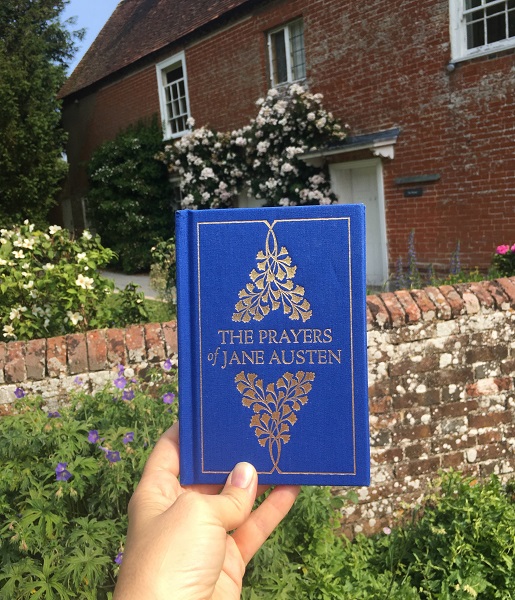I thought of Jane Austen today on the eve of the 205th anniversary of her death in Winchester. At only 42 years of age, she left us a legacy so rich that her genius as a writer is regaled to this day. Several days prior to her death on July 18, 1817, she wrote the following poem about the Winchester races.

Ascot Heath Race for His Majesty’s Gold Plate, James Pollard, 1826, Yale Center for British Art, Wikimedia Commons. While this is not an image of the Winchester racing stands, one can gain a good idea of the size of the crowds and their enthusiasm.
When Winchester Races
When Winchester races first took their beginning
It is said the good people forgot their old Saint
Not applying at all for the leave of Saint Swithin
And that William of Wykeham’s approval was faint.
The races however were fixed and determined
The company came and the Weather was charming
The Lords and the Ladies were satine’d and ermined
And nobody saw any future alarming.–
But when the old Saint was informed of these doings
He made but one Spring from his Shrine to the Roof
Of the Palace which now lies so sadly in ruins
And then he addressed them all standing aloof.
‘Oh! subjects rebellious! Oh Venta depraved
When once we are buried you think we are gone
But behold me immortal! By vice you’re enslaved
You have sinned and must suffer, ten farther he said
These races and revels and dissolute measures
With which you’re debasing a neighboring Plain
Let them stand–You shall meet with your curse in your pleasures
Set off for your course, I’ll pursue with my rain.
Ye cannot but know my command o’er July
Henceforward I’ll triumph in shewing my powers
Shift your race as you will it shall never be dry
The curse upon Venta is July in showers–‘.
– Jane Austen
About the poem:
When it was written:
“Jane Austen wrote this poem just two days before her death, on 15 July 1817, which was the day of the Winchester Races, a fashionable race day and also St. Swithin’s Day. – Jane Austen’s House Museum
St Swithin:
St Swithin, a 9th century bishop, patron saint of Winchester, is linked through long tradition to the idea that if it rains on his feast day, it will continue to rain for 40 days and nights. The summer of 1817 was notably wet…” – Jane Austen’s House Museum
Venta:
Winchester’s old name, which dates from Roman times.
About the Winchester Races during the 18th-19th Centuries:
During both centuries races, such as the Winchester Races, welcomed all people from every segment of society, whether they were betting or enjoying the social events. Groups of hairdressers and milliners traveled from London and Bath to Winchester during their respective racing seasons to provide fashionable services (and between 1781 and 1790 the ‘finest assortment of French Pomades and coloured powders’). London’s season, linked to the sessions in Parliament, began in February at the start of the opening session. Many did not arrive until after the fox-hunting season at the end of March. Horse racing was an important component of each social season in the aforementioned cities.
The Winchester Races were held in late June/early July each season, from Tuesday until Thursday during one week. The city’s annual social calendar revolved around the social seasons of winter and summer. Amusements ranged from balls, assemblies, cockfighting, public breakfasts, fairs, etc. During race week, public breakfasts and balls were held daily. An annual performance by the Winchester College boys included a reading of a selection of prose and a music festival were also organized.

A View of the Road to Newmarket Races, James Pollard, Yale Center of British Art, Wikimedia Commons.While this scene is about the crowds going to the Newmarket Races, one can imagine a similar group heading for Winchester in 1817.
These annual races drew people from all walks of life for nearly a fortnight. Genteel society took advantage of the social events to show off their finery, of which, as previously mentioned, certain working groups took full advantage. The change in racing venues provided an opportunity for visitors to move from a stifling London to fresher more rural environments, with the added attraction of more gambling opportunities.
Royalty was at times present at the Winchester races, but the ‘the bulk of its pleasurable amenities was utilised by the county gentry. Winchester society was well patronised by the Duke of Chandos and the Pawlett family (Marquesses of Winchester), as well as a host of others who were noted in the newspapers..’ – Proc. Hampshire Field Club Archived. Soc. 54,1999, 127-145 (Hampshire Studies 1999) LEISURE AND SOCIETY IN GEORGIAN WINCHESTER, By M COOPER
I don’t know what happened to Jane Austen’s original copy of the poem. This site by the Jane Austen’s House Museum offers a facsimile in her sister Cassandra’s hand. (Link to the Winchester Verses). On 24 May 1817, she left Chawton with Cassandra and moved into lodgings in Winchester to be near Dr Lyford at the County Hospital. Her illness however rapidly worsened and she died on 18 July 1817.
“The poem, which is written in cross-rhymed quatrains, was initially suppressed by [Jane’s] Victorian-era family, and later released in edited versions that changed words and punctuation (including one version that altered the word “dead” to “gone”. They thought that joking about St. Swithin and horse racing and death would be dimly viewed by the public.” –Kelly R. Fineman
Austen Family Poetry:
Jane’s family left a legacy of letters, poems, riddles, and charades, which are charmingly captured by David Selwyn in his book, The Poetry of Jane Austen and the Austen Family. Below is a link to a youtube video on the Winchester City Museum site, in which another one of Jane’s poems is captured.















 Inquiring readers,
Inquiring readers, ![1_P1040161_WINCHESTER_CATHEDRAL[1]](https://janeaustensworld.files.wordpress.com/2019/03/1_p1040161_winchester_cathedral1.jpg)
![2_P1030843_nave[1]](https://janeaustensworld.files.wordpress.com/2019/03/2_p1030843_nave1.jpg)
![3_P1040022_grave_with_3_flowers[1]](https://janeaustensworld.files.wordpress.com/2019/03/3_p1040022_grave_with_3_flowers1.jpg)
![4_P1040007_website_with_bust[1]](https://janeaustensworld.files.wordpress.com/2019/03/4_p1040007_website_with_bust1.jpg)
![5_P1040041_website_signing_memory_book[1]](https://janeaustensworld.files.wordpress.com/2019/03/5_p1040041_website_signing_memory_book1.jpg)
![6_P1040146_college_street[1]](https://janeaustensworld.files.wordpress.com/2019/03/6_p1040146_college_street1.jpg)
![7_P1040139_website_nancy_at_front_door[1]](https://janeaustensworld.files.wordpress.com/2019/03/7_p1040139_website_nancy_at_front_door1.jpg)
![8_P1040106_website_dog_close_up[1]](https://janeaustensworld.files.wordpress.com/2019/03/8_p1040106_website_dog_close_up1.jpg)
![9_P1040124_website_film_crew[1]](https://janeaustensworld.files.wordpress.com/2019/03/9_p1040124_website_film_crew1.jpg)












